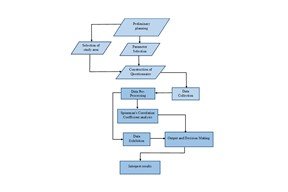Evaluating the parameters influencing agricultural productivity due to the limitations of smartphone-related knowledge among farmers
Abstract
The use of smartphones has improved individuals significantly in this age of information technology. Yet farmers cannot use this smartphone due to a lack of proper knowledge. Where smartphones could easily be used by farmers to solve their agricultural problems. The aims of the study to improve the daily life of a farmer as well as to gain skills in the use of smart phones. Nine characters have been selected to find out the relation between knowledge of farmers' use of smartphones in agriculture. The data are collected through interviews from 128 farm families from Mymensingh of Bangladesh. A semi-structured questionnaire is distributed for collecting data. Those data were pre-arranged and categorized by using M.S. Excel. Spearman's Rank Order were used to create correlations among the characteristics of farmers. Among the selected farmers 56% have low knowledge and only 3% of farmers have high knowledge about the use of smartphones in the agricultural sector. Among nine characters ages and firm experience have a strong negative significant correlation (-0.548* and -0.541*, respectively). On the other hand, extension media interaction has a strong positive relationship (0.588*). From this output, farmers will be able to gain a complete understanding of smartphones to solve the agricultural problems with proper training and experience.
Keywords:
Farmer development, Farmer knowledge, Modern technology, Smartphone useDownloads
References
Bartlett, A. C., Andales, A. A., Arabi, M., & Bauder, T. A. (2015). A smartphone app to extend use of a cloud-based irrigation scheduling tool. Computers and Electronics in Agriculture, 111, 127-130, https://doi.org/10.1016/j.compag.2014.12.021
Corrocher, N., & Zirulia, L. (2009). Me and you and everyone we know: An empirical analysis of local network effects in mobile communications. Telecommunications Policy, 33(1-2), 68-79, https://doi.org/10.1016/j.telpol.2008.10.003
Delgado, J. A., Kowalski, K., & Tebbe, C. (2013). The first Nitrogen Index app for mobile devices: Using portable technology for smart agricultural management. Computers and electronics in agriculture, 91, 121-123, https://doi.org/10.1016/j.compag.2012.12.008
Folnovic, T. (n.d.). Smart Agriculture on Smartphones. AGRIVI. Retrieved December 27, 2020, from https://blog.agrivi.com/post/smart-agriculture-on-smartphones
Furuholt, B., & Matotay, E. (2011). The developmental contribution from mobile phones across the agricultural value chain in rural Africa. The Electronic Journal of Information Systems in Developing Countries, 48(1), 1-16, https://doi.org/10.1002/j.1681-4835.2011.tb00343.x
Kirui, O. K., Okello, J. J., Nyikal, R. A., & Njiraini, G. W. (2013). Impact of mobile phone-based money transfer services in agriculture: evidence from Kenya. Quarterly Journal of International Agriculture, 52(892-2016-65177), 141-162, http://doi.org/10.22004/ag.econ.173644
Krell, N. T., Giroux, S. A., Guido, Z., Hannah, C., Lopus, S. E., Caylor, K. K., & Evans, T. P. (2021). Smallholder farmers' use of mobile phone services in central Kenya. Climate and Development, 13(3), 215-227,https://doi.org/10.1080/17565529.2020.1748847
Mamun-ur-Rashid, M., Karim, M. M., Islam, M. M., & Mobarak, M. S. B. (2019). The usefulness of cell phones for crop farmers in selected regions of Bangladesh. Asian Journal of Agriculture and Rural Development, 9(2), 298-312,https://doi.org/10.18488/journal.1005/2019.9.2/1005.2.298.312
Martin, B. L., & Abbott, E. (2011). Mobile phones and rural livelihoods: Diffusion, uses, and perceived impacts among farmers in rural Uganda. Information Technologies & International Development, 7(4), 17-34, http://itidjournal.org/index.php/itid/article/view/789.html
McKay, F. H., Cheng, C., Wright, A., Shill, J., Stephens, H., & Uccellini, M. (2018). Evaluating mobile phone applications for health behaviour change: A systematic review. Journal of telemedicine and telecare, 24(1), 22-30, https://doi.org/10.1177/1357633X16673538
Mittal, S., Gandhi, S., & Tripathi, G. (2010). Socio-economic impact of mobile phones on Indian agriculture (No. 246). Working paper. http://hdl.handle.net/10419/176264
Niu, G., Yao, L., Wu, L., Tian, Y., Xu, L., & Sun, X. (2020). Parental phubbing and adolescent problematic mobile phone use: The role of parent-child relationship and self-control. Children and Youth Services Review, 116, 105247, https://doi.org/10.1016/j.childyouth.2020.105247
OBERLO (2021). How many people have smartphones in 2021? Retrieved December 27, 2020, from https://www.oberlo.com/statistics/how-many-people-have-smartphones
Ogbeide, O. A., & Ele, I. (2015). Smallholder farmers and mobile phone technology in Sub-Sahara Agriculture. Mayfair Journal of Information and Technology Management in Agriculture, 1(1), 1-19.
Rodríguez-García, A. M., Moreno-Guerrero, A. J., & Lopez Belmonte, J. (2020). Nomophobia: An individual’s growing fear of being without a smartphone—a systematic literature review. International Journal of Environmental Research and Public Health, 17(2), 580, https://doi.org/10.3390/ijerph17020580
Russo, M., Bergami, M., & Morandin, G. (2018). Surviving a day without smartphones. MIT Sloan Management Review, 59(2), 7-9.
Turner, A. (2021). How many smartphones are in the world? BankMyCell. Retrieved December 27, 2021, from https://www.bankmycell.com/blog/how-many-phones-are-in-the-world
Vanhoof, M., Reis, F., Ploetz, T., & Smoreda, Z. (2018). Assessing the quality of home detection from mobile phone data for official statistics. Journal of Official Statistics, 34(4), 935-960, https://doi.org/10.2478/jos-2018-0046
BOYRA. (2021, january 10). City Population. https://www.citypopulation.de/en/bangladesh/dhaka/admin/manikganj/568219__boyra/?fbclid=IwAR34-ZSOOcbL0VJo8IgEsvhUVRwW6D_3fBlGdTlk5NGjFVPWa4ekHMEmep4
Wikipedia contributors. (2021, November 16). List of countries by smartphone penetration. In Wikipedia, The Free Encyclopedia. Retrieved 09:24, December 27, 2021, from https://en.wikipedia.org/w/index.php?title=List_of_countries_by_smartphone_penetration&oldid=1055632092

Published
How to Cite
Issue
Section
Copyright (c) 2022 Agriculture and Environmental Science Academy

This work is licensed under a Creative Commons Attribution-NonCommercial 4.0 International License.

